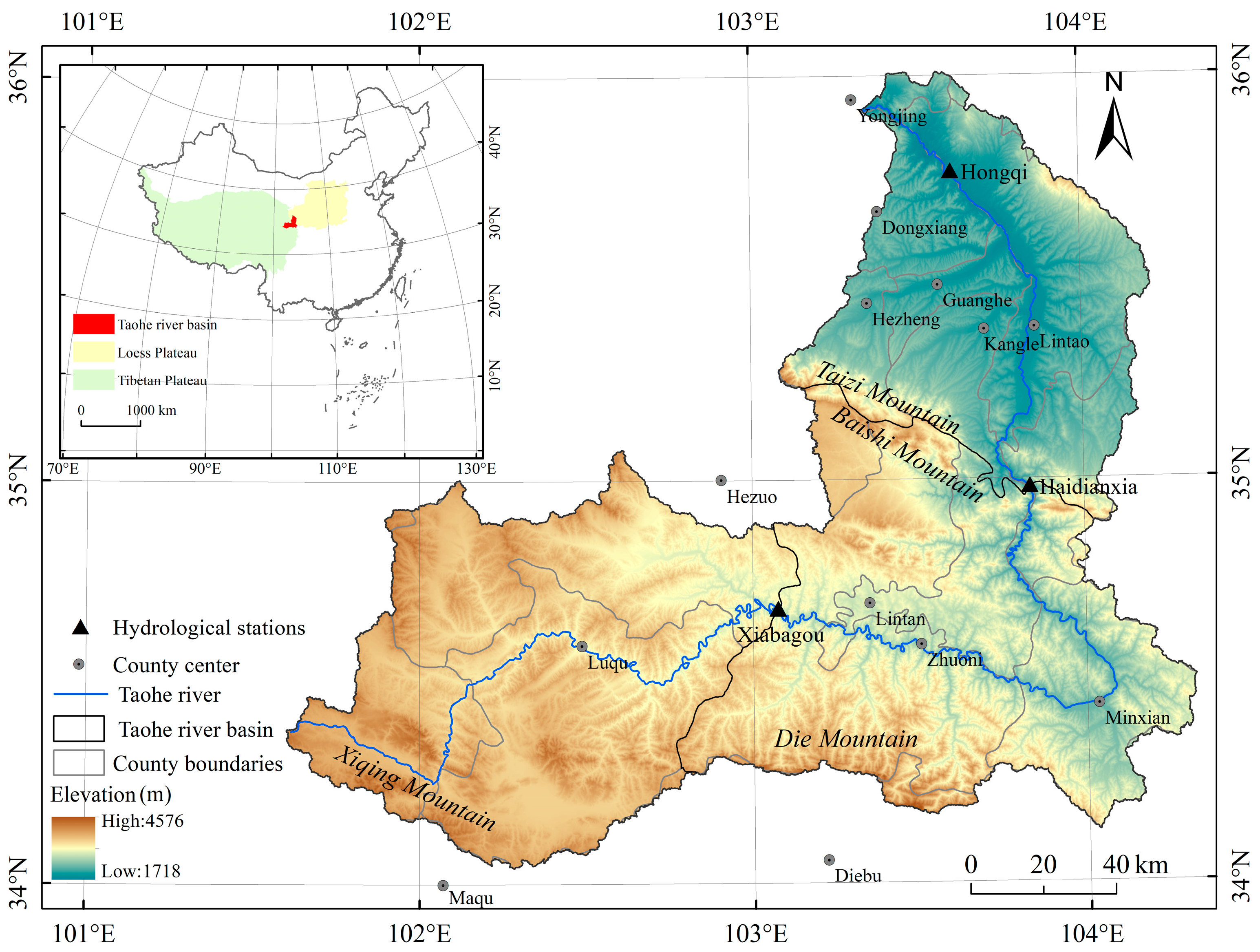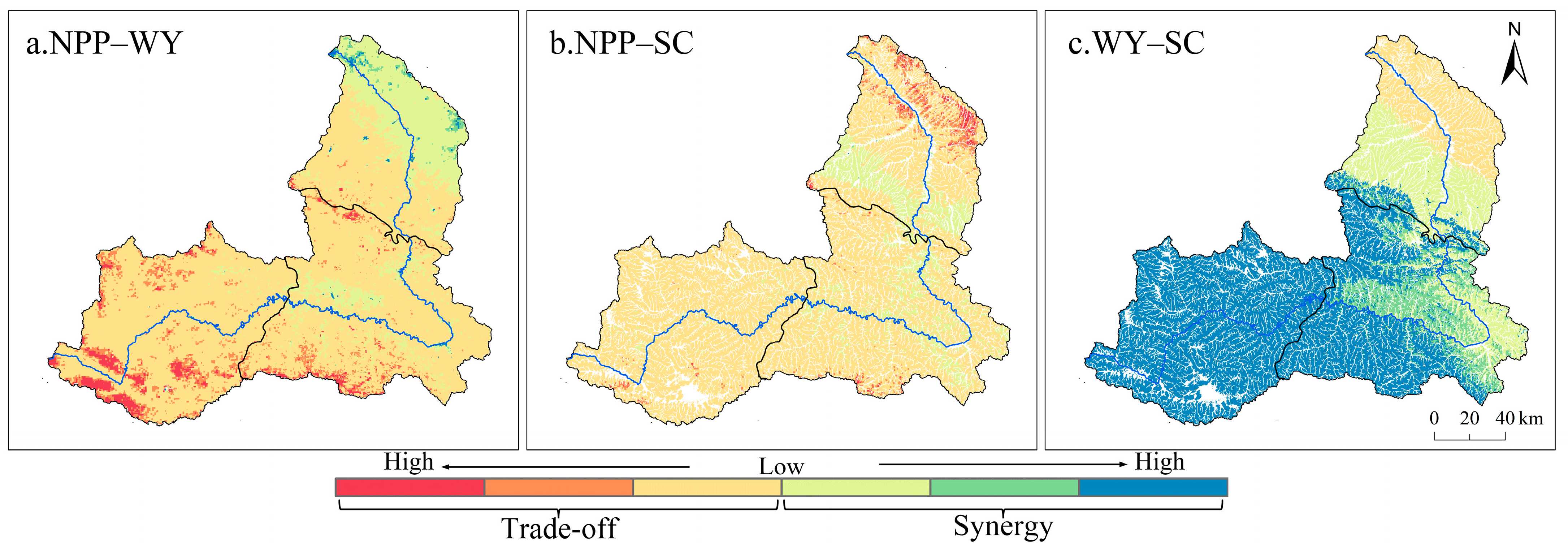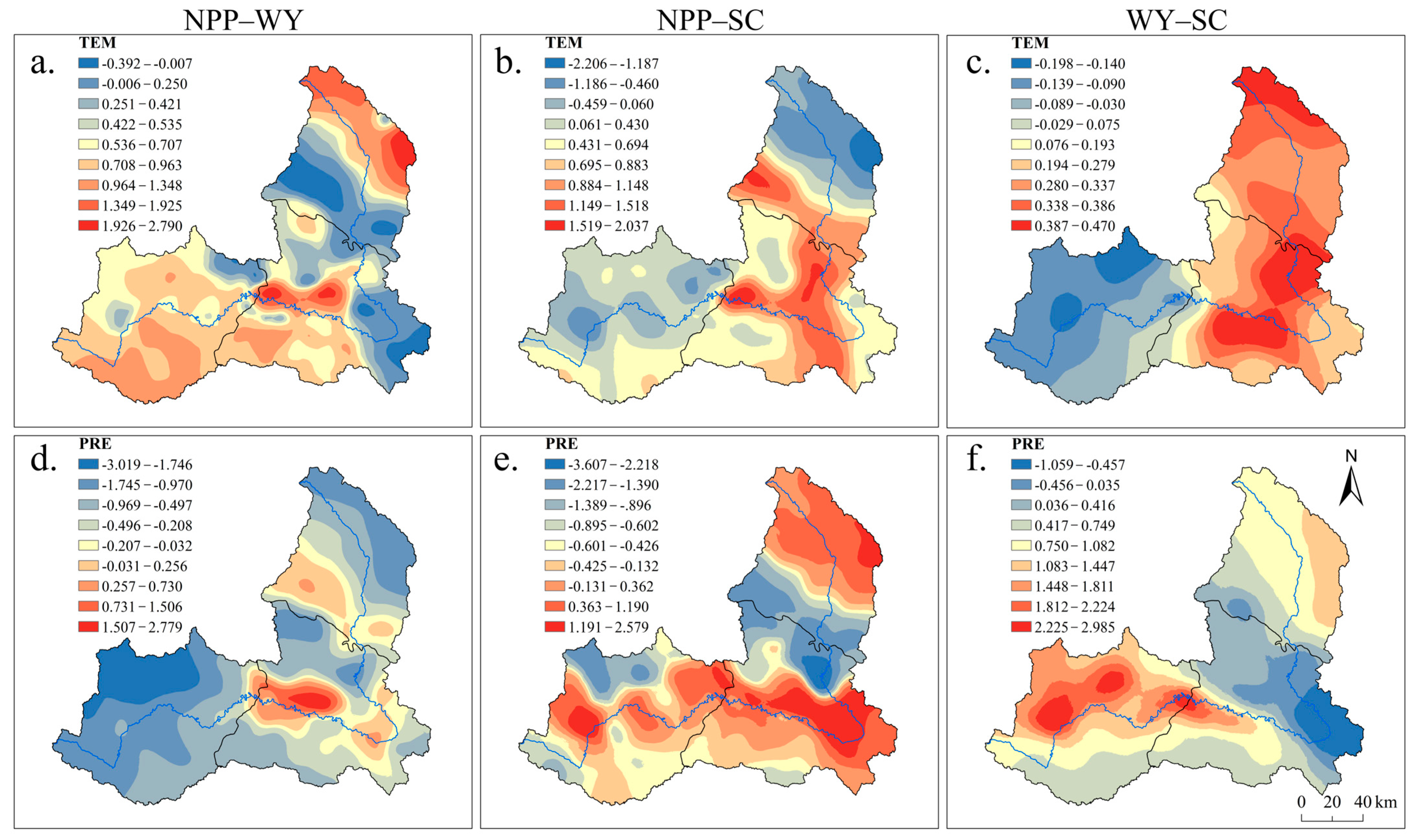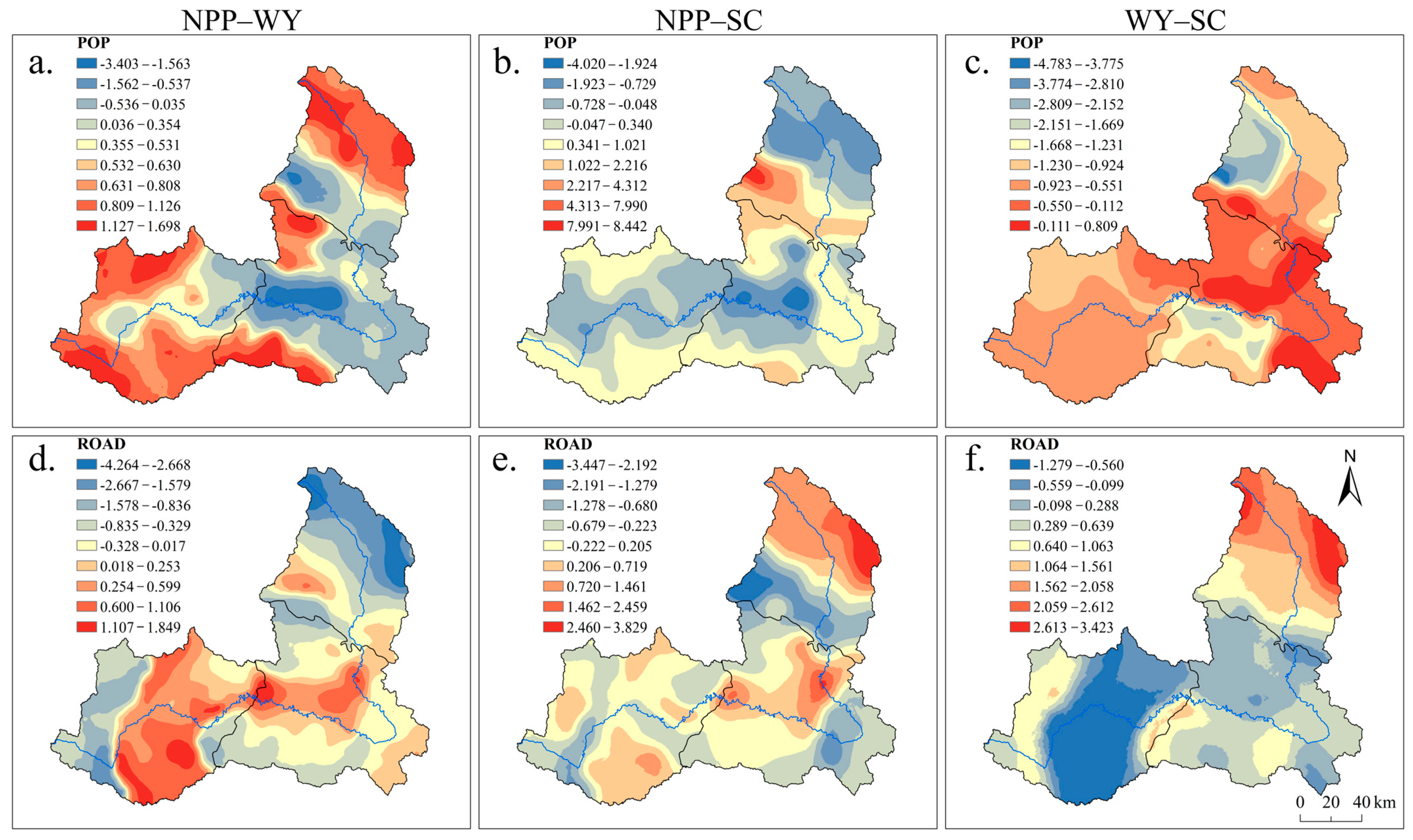Research on the Trade-Offs and Synergies of Ecosystem Services and Their Impact Factors in the Taohe River Basin
Abstract
:1. Introduction
2. Materials and Methods
2.1. Study Area
2.2. Data Sources and Processing
2.3. Quantifying ESs
2.4. Trade-Offs and Synergy Analysis
2.4.1. Analysis of ESs Trade-Offs and Synergies
2.4.2. ESs Trade-Offs and Synergistic Impact Factor Detection
2.4.3. Analysis of ES Trade-Offs and Synergistic Impact Factors
3. Results
3.1. Spatiotemporal Pattern of ESs
3.2. ESs Trade-Offs and Synergies
3.3. Identification of Dominant Factors for Relationships between ESs
3.4. Analysis of ESs Trade-Offs and Synergistic Impact Factors
4. Discussion
4.1. Analysis of ESs Trade-Offs and Synergistic Features
4.2. Management Based on Trade-Offs and Synergies
4.3. Limitations and Perspectives
5. Conclusions
Author Contributions
Funding
Institutional Review Board Statement
Informed Consent Statement
Data Availability Statement
Acknowledgments
Conflicts of Interest
References
- Lévêque, C. Ecology: From Ecosystem to Biosphere; Science Publishers: Rawalpindi, Pakistan, 2003. [Google Scholar]
- Li, W.; Zhang, B.; Xie, G. Research on ecosystem services in China: Progress and perspectives. J. Nat. Resour. 2009, 24, 1–10. [Google Scholar]
- Assessment, M.E. Ecosystems and Human Well-Being: Wetlands and Water; World Resources Institute: Washington, DC, USA, 2005. [Google Scholar]
- Pereira, E.; Queiroz, C.; Pereira, H.M.; Vicente, L. Ecosystem services and human well-being: A participatory study in a mountain community in Portugal. Ecol. Soc. 2005, 10, 14. [Google Scholar] [CrossRef]
- Costanza, R.; d’Arge, R.; De Groot, R.; Farber, S.; Grasso, M.; Hannon, B.; Limburg, K.; Naeem, S.; O’neill, R.V.; Paruelo, J. The value of the world’s ecosystem services and natural capital. Nature 1997, 387, 253–260. [Google Scholar] [CrossRef]
- Busch, M.; La Notte, A.; Laporte, V.; Erhard, M. Potentials of quantitative and qualitative approaches to assessing ecosystem services. Ecol. Indic. 2012, 21, 89–103. [Google Scholar] [CrossRef]
- Howe, C.; Suich, H.; Vira, B.; Mace, G.M. Creating win-wins from trade-offs? Ecosystem services for human well-being: A meta-analysis of ecosystem service trade-offs and synergies in the real world. Glob. Environ. Chang. 2014, 28, 263–275. [Google Scholar] [CrossRef] [Green Version]
- Li, S.; Zhang, C.; Liu, J.; Zhu, W.; Ma, C.; Wang, J. The tradeoffs and synergies of ecosystem services: Research progress, development trend, and themes of geography. Geogr. Res. 2013, 32, 1379–1390. [Google Scholar]
- Pedrono, M.; Locatelli, B.; Ezzine-de-Blas, D.; Pesche, D.; Morand, S.; Binot, A. Impact of climate change on ecosystem services. In Climate Change and Agriculture Worldwide; Springer: Berlin/Heidelberg, Germany, 2016; pp. 251–261. [Google Scholar]
- Mooney, H.; Larigauderie, A.; Cesario, M.; Elmquist, T.; Hoegh-Guldberg, O.; Lavorel, S.; Mace, G.M.; Palmer, M.; Scholes, R.; Yahara, T. Biodiversity, climate change, and ecosystem services. Curr. Opin. Environ. Sustain. 2009, 1, 46–54. [Google Scholar] [CrossRef]
- Yang, S.; Zhao, W.; Liu, Y.; Wang, S.; Wang, J.; Zhai, R. Influence of land use change on the ecosystem service trade-offs in the ecological restoration area: Dynamics and scenarios in the Yanhe watershed, China. Sci. Total Environ. 2018, 644, 556–566. [Google Scholar] [CrossRef]
- Feng, Z.; Jin, X.; Chen, T.; Wu, J. Understanding trade-offs and synergies of ecosystem services to support the decision-making in the Beijing–Tianjin–Hebei region. Land Use Policy 2021, 106, 105446. [Google Scholar] [CrossRef]
- Cord, A.F.; Bartkowski, B.; Beckmann, M.; Dittrich, A.; Hermans-Neumann, K.; Kaim, A.; Lienhoop, N.; Locher-Krause, K.; Priess, J.; Schröter-Schlaack, C. Towards systematic analyses of ecosystem service trade-offs and synergies: Main concepts, methods and the road ahead. Ecosyst. Serv. 2017, 28, 264–272. [Google Scholar] [CrossRef]
- Dai, E.; Wang, X.; Zhu, J.; Zhao, D. Methods, tools and research framework of ecosystem service trade-offs. Geogr. Res. 2016, 35, 1005–1016. [Google Scholar]
- Shen, J.; Li, S.; Liang, Z.; Liu, L.; Li, D.; Wu, S. Exploring the heterogeneity and nonlinearity of trade-offs and synergies among ecosystem services bundles in the Beijing-Tianjin-Hebei urban agglomeration. Ecosyst. Serv. 2020, 43, 101103. [Google Scholar] [CrossRef]
- Ran, C.; Wang, S.; Bai, X.; Tan, Q.; Zhao, C.; Luo, X.; Chen, H.; Xi, H. Trade-offs and synergies of ecosystem services in southwestern China. Environ. Eng. Sci. 2020, 37, 669–678. [Google Scholar] [CrossRef]
- Shao, Y.; Xiao, Y.; Sang, W. Land use trade-offs and synergies based on temporal and spatial patterns of ecosystem services in South China. Ecol. Indic. 2022, 143, 109335. [Google Scholar] [CrossRef]
- Burkhard, B.; Kroll, F.; Nedkov, S.; Müller, F. Mapping ecosystem service supply, demand and budgets. Ecol. Indic. 2012, 21, 17–29. [Google Scholar] [CrossRef]
- Yang, X.; Zhou, Z.; Li, J.; Fu, X.; Mu, X.; Li, T. Trade-offs between carbon sequestration, soil retention and water yield in the Guanzhong-Tianshui Economic Region of China. J. Geogr. Sci. 2016, 26, 1449–1462. [Google Scholar] [CrossRef]
- Chen, T.; Huang, Q.; Wang, Q. Differentiation characteristics and driving factors of ecosystem services relationships in karst mountainous area based on geographic detector modeling: A case study of Guizhou Province. Acta Ecol. Sin. 2022, 42, 6959–6972. [Google Scholar]
- Nazeer, M.; Bilal, M. Evaluation of ordinary least square (OLS) and geographically weighted regression (GWR) for water quality monitoring: A case study for the estimation of salinity. J. Ocean Univ. China 2018, 17, 305–310. [Google Scholar] [CrossRef]
- Zhu, C.; Zhang, X.; Zhou, M.; He, S.; Gan, M.; Yang, L.; Wang, K. Impacts of urbanization and landscape pattern on habitat quality using OLS and GWR models in Hangzhou, China. Ecol. Indic. 2020, 117, 106654. [Google Scholar] [CrossRef]
- Mahara, D.O.; Fauzan, A. Impacts of Human Development Index and Percentage of Total Population on Poverty using OLS and GWR models in Central Java, Indonesia. EKSAKTA J. Sci. Data Anal. 2021, 2, 142–154. [Google Scholar] [CrossRef]
- Zhang, Z.; Liu, Y.; Wang, Y.; Liu, Y.; Zhang, Y.; Zhang, Y. What factors affect the synergy and tradeoff between ecosystem services, and how, from a geospatial perspective? J. Clean. Prod. 2020, 257, 120454. [Google Scholar] [CrossRef]
- Chen, J.; Wang, Y.; Sun, J.; Liang, E.; Shen, M.; Yang, B.; Jia, X.; Zhang, J. Precipitation dominants synergies and trade-offs among ecosystem services across the Qinghai-Tibet Plateau. Glob. Ecol. Conserv. 2021, 32, e01886. [Google Scholar] [CrossRef]
- Oshan, T.M.; Li, Z.; Kang, W.; Wolf, L.J.; Fotheringham, A.S. mgwr: A Python implementation of multiscale geographically weighted regression for investigating process spatial heterogeneity and scale. ISPRS Int. J. Geo-Inf. 2019, 8, 269. [Google Scholar] [CrossRef] [Green Version]
- Fathurahman, M.; Ratnasari, V. Geographically weighted multivariate logistic regression model and its application. Abstr. Appl. Anal. 2020, 2020, 8353481. [Google Scholar] [CrossRef]
- Yang, L.; Feng, Q.; Li, C.; Si, J.; Wen, X.; Yin, Z. Detecting climate variability impacts on reference and actual evapotranspiration in the Taohe River Basin, NW China. Hydrol. Res. 2017, 48, 596–612. [Google Scholar] [CrossRef] [Green Version]
- Liu, Z.; Chen, X.; Guan, X.; Shu, Z.; Yang, X.; Wang, G. Attribution of runoff change in the Taohe River Basin under a changing environment. Res. Soil Water Conserv. 2020, 27, 87–92+100. [Google Scholar]
- Li, C.; Yang, L.; Yang, W.; Wang, S. Land use and land cover change in Taohe River Basin and its driving forces. Sci. Geogr. Sin. 2014, 34, 848–855. [Google Scholar]
- Jianbing, W. Trend analysis for the variety of arid index in Taohe River basin in recent 40 years. Agric. Res. Arid Areas 2014, 32, 246–250. [Google Scholar]
- Wang, H.; Zhao, H. Dynamic changes of soil erosion in the taohe river basin using the RUSLE model and google earth engine. Water 2020, 12, 1293. [Google Scholar] [CrossRef]
- Li, C.; Wang, L.; Wanrui, W.; Qi, J.; Linshan, Y.; Zhang, Y.; Lei, W.; Cui, X.; Wang, P. An analytical approach to separate climate and human contributions to basin streamflow variability. J. Hydrol. 2018, 559, 30–42. [Google Scholar] [CrossRef]
- Cheng, L.; Wan, G.; Yang, M.; Wang, X.; Li, Y. The Runoff in the Upper Taohe River Basin and Its Responses to Climate Change. Water 2022, 14, 2094. [Google Scholar] [CrossRef]
- Zhu, L.; Liu, R.; Wen, J.; Zhao, M.; Wang, C. Climate change and drought evolution in the Tao River Basin in the past 50 years. J. Arid Meteorol. 2018, 36, 234–242. [Google Scholar]
- Li, C.; Wang, S.; Yang, L.; Yang, W.; Li, W. Spatial and temporal variation of meteorologica elementsin the Taohe River Basin from 1951 to 2010. J. Glaciol. Geocryol. 2013, 35, 1259–1266. [Google Scholar]
- Zhang, J.-S.; Kang, E.-S.; Lan, Y.-C.; Chen, R.-S.; Yao, J.-Z.; Pu, R.-F.; Chen, M.-X. Trend Analysis of the Precipitation and Runoff in the Taohe River Watershed during the Past 50 Years. J. Glaciol. Geocryol. 2003, 25, 72–82. [Google Scholar]
- Wang, S.; Li, C.; Yang, L. Drought trend analysis based on standardized precipitation index and the Z index in the Tao River Basin. Arid Zone Res. 2015, 32, 565–572. [Google Scholar]
- Zhou, F.-C.; Han, X.; Tang, S.; Song, X.; Wang, H. An improved model for evaluating ecosystem service values using land use/cover and vegetation parameters. J. Meteorol. Res. 2021, 35, 148–156. [Google Scholar] [CrossRef]
- Fotheringham, A.S.; Yang, W.; Kang, W. Multiscale geographically weighted regression (MGWR). Ann. Am. Assoc. Geogr. 2017, 107, 1247–1265. [Google Scholar] [CrossRef]
- Quanqin, S.; Jiangwen, F.; Jiyuan, L.; Fan, Y.; Hua, L.; Xiuchun, Y.; Mingxiang, X.; Peng, H.; Xingjian, G.; Lin, H. Approaches for monitoring and assessment of ecological benefits of national key ecological projects. Adv. Earth Sci. 2017, 32, 1174. [Google Scholar]
- Wang, S.; Jin, T.; Yan, L.; Gong, J. Ecosystem services trade-off and synergy change in the Ziwuling Region, Northwest China and their influencing factors. Chin. J. Appl. Ecol. 2022, 33, 3087–3096. [Google Scholar]
- Chen, X.; Wang, X.; Feng, X.; Zhang, X.; Luo, G. Ecosystem service trade-off and synergy on Qinghai-Tibet Plateau. Geogr. Res. 2021, 40, 18–34. [Google Scholar]
- Niu, L.; Shao, Q.; Ning, J.; Huang, H. Ecological changes and the tradeoff and synergy of ecosystem services in western China. J. Geogr. Sci. 2022, 32, 1059–1075. [Google Scholar] [CrossRef]
- Gyssels, G.; Poesen, J.; Bochet, E.; Li, Y. Impact of plant roots on the resistance of soils to erosion by water: A review. Prog. Phys. Geogr. 2005, 29, 189–217. [Google Scholar] [CrossRef] [Green Version]
- Sun, G.; Zhou, G.; Zhang, Z.; Wei, X.; McNulty, S.G.; Vose, J.M. Potential water yield reduction due to forestation across China. J. Hydrol. 2006, 328, 548–558. [Google Scholar] [CrossRef]
- Fu, Q.; Li, B.; Hou, Y.; Bi, X.; Zhang, X. Effects of land use and climate change on ecosystem services in Central Asia’s arid regions: A case study in Altay Prefecture, China. Sci. Total Environ. 2017, 607, 633–646. [Google Scholar] [CrossRef] [PubMed]
- Gong, J.; Liu, D.; Zhang, J.; Xie, Y.; Cao, E.; Li, H. Tradeoffs/synergies of multiple ecosystem services based on land use simulation in a mountain-basin area, western China. Ecol. Indic. 2019, 99, 283–293. [Google Scholar] [CrossRef]
- Han, Z.; Song, W.; Deng, X.; Xu, X. Trade-offs and synergies in ecosystem service within the three-rivers headwater region, China. Water 2017, 9, 588. [Google Scholar] [CrossRef] [Green Version]
- Sun, Y.; Liu, S.; Liu, Y.; Dong, Y.; Li, M.; An, Y.; Shi, F.; Beazley, R. Effects of the interaction among climate, terrain and human activities on biodiversity on the Qinghai-Tibet Plateau. Sci. Total Environ. 2021, 794, 148497. [Google Scholar] [CrossRef]
- He, J.; Shi, X.; Fu, Y. Identifying vegetation restoration effectiveness and driving factors on different micro-topographic types of hilly Loess Plateau: From the perspective of ecological resilience. J. Environ. Manag. 2021, 289, 112562. [Google Scholar] [CrossRef]
- Mahmoud, S.H.; Gan, T.Y. Impact of anthropogenic climate change and human activities on environment and ecosystem services in arid regions. Sci. Total Environ. 2018, 633, 1329–1344. [Google Scholar] [CrossRef]
- Desta, H.; Lemma, B.; Fetene, A. Aspects of climate change and its associated impacts on wetland ecosystem functions: A review. J. Am. Sci. 2012, 8, 582–596. [Google Scholar]
- Yang, M.; Gao, X.; Zhao, X.; Wu, P. Scale effect and spatially explicit drivers of interactions between ecosystem services—A case study from the Loess Plateau. Sci. Total Environ. 2021, 785, 147389. [Google Scholar] [CrossRef]
- Liu, L.; Wang, Z.; Wang, Y.; Zhang, Y.; Shen, J.; Qin, D.; Li, S. Trade-off analyses of multiple mountain ecosystem services along elevation, vegetation cover and precipitation gradients: A case study in the Taihang Mountains. Ecol. Indic. 2019, 103, 94–104. [Google Scholar] [CrossRef]
- Zuazo, V.H.D.; Pleguezuelo, C.R.R. Soil-erosion and runoff prevention by plant covers: A review. Sustain. Agric. 2009, 28, 785–811. [Google Scholar]
- Fatichi, S.; Ivanov, V.Y. Interannual variability of evapotranspiration and vegetation productivity. Water Resour. Res. 2014, 50, 3275–3294. [Google Scholar] [CrossRef]
- Whitehead, P.G.; Wilby, R.L.; Battarbee, R.W.; Kernan, M.; Wade, A.J. A review of the potential impacts of climate change on surface water quality. Hydrol. Sci. J. 2009, 54, 101–123. [Google Scholar] [CrossRef] [Green Version]
- Ma, S.; Wang, L.-J.; Jiang, J.; Chu, L.; Zhang, J.-C. Threshold effect of ecosystem services in response to climate change and vegetation coverage change in the Qinghai-Tibet Plateau ecological shelter. J. Clean. Prod. 2021, 318, 128592. [Google Scholar] [CrossRef]
- Zhao, T.; Pan, J.; Bi, F. Can human activities enhance the trade-off intensity of ecosystem services in arid inland river basins? Taking the Taolai River asin as an example. Sci. Total Environ. 2023, 861, 160662. [Google Scholar] [CrossRef]
- Qian, C.; Gong, J.; Zhang, J.; Liu, D.; Ma, X. Change and tradeoffs-synergies analysis on watershed ecosystem services: A case study of Bailongjiang Watershed, Gansu. Acta Geogr. Sin. 2018, 73, 868–879. [Google Scholar]
- Wang, Y.; Dai, E. Spatial-temporal changes in ecosystem services and the trade-off relationship in mountain regions: A case study of Hengduan Mountain region in Southwest China. J. Clean. Prod. 2020, 264, 121573. [Google Scholar] [CrossRef]
- Yu, Y.; Li, J.; Zhou, Z.; Ma, X.; Zhang, X. Response of multiple mountain ecosystem services on environmental gradients: How to respond, and where should be priority conservation? J. Clean. Prod. 2021, 278, 123264. [Google Scholar] [CrossRef]
- Li, W.; Zhao, X.; Du, Y.; Ma, P. Spatio-temporal changes of the coupling relationship between ecosystem services and residents’ well-being in Qinba. J. Nat. Resour. 2021, 36, 2522–2540. [Google Scholar] [CrossRef]
- Feng, Q.; Zhao, W.; Fu, B.; Ding, J.; Wang, S. Ecosystem service trade-offs and their influencing factors: A case study in the Loess Plateau of China. Sci. Total Environ. 2017, 607, 1250–1263. [Google Scholar] [CrossRef] [PubMed]









| ESs | Models | Mathematical Algorithms |
|---|---|---|
| NPP | CASA | |
| : net primary productivity of vegetation at a time for pixels (gC/m2); : photosynthetically active radiation absorbed by pixels at a time (MJ/m2); : actual light energy utilization at a time for pixels (gC/MJ). | ||
| WY | Water yield module of InVEST | |
| : annual water yield of the pixels (mm); : actual annual evapotranspiration of the pixels (mm); : annual precipitation of the pixels (mm). | ||
| SC | Sediment retention module of InVEST | |
| : soil conservation amount (t/hm2); : potential soil erosion amount (t/hm2); : actual soil erosion amount under ecological management measures (t/hm2); , , , and indicate rainfall erosion factor, soil erosion factor, slope length slope factor, vegetation cover and management factor, and measure factor of soil and water conservation, respectively. |
| Cropland | Forest | Grassland | Shrubs | Water | Bare | Constructed Land | Total | ||
|---|---|---|---|---|---|---|---|---|---|
| NPP–WY | Trade-off | 3791.52 | 2596.86 | 13,888.49 | 371.52 | 5.85 | 1.08 | 7.29 | 20,662.61 |
| Synergy | 1698.75 | 370.62 | 2410.74 | 48.06 | 42.3 | 0.09 | 4.77 | 4575.33 | |
| NPP–SC | Trade-off | 2812.14 | 2062.71 | 11,699.79 | 287.46 | 3.51 | 1.08 | 1.44 | 16,868.13 |
| Synergy | 1217.7 | 315.27 | 875.52 | 59.49 | 7.92 | 0 | 0 | 2475.9 | |
| WY–SC | Trade-off | 843.75 | 0.18 | 1387.62 | 0.27 | 1.35 | 0.09 | 0 | 2233.26 |
| Synergy | 3185.55 | 2377.8 | 11,187.36 | 346.68 | 10.08 | 0.99 | 0.72 | 17,109.18 |
| Natural Factors | Social Factors | |||||||||
|---|---|---|---|---|---|---|---|---|---|---|
| TEM | PRE | DEM | NDVI | SOIL | GDP | POP | ROAD | CROP | LU | |
| NPP–WY | 0.48 | 0.45 | 0.50 | 0.37 | 0.16 | 0.18 | 0.32 | 0.04 | 0.38 | 0.06 |
| NPP–SC | 0.16 | 0.21 | 0.16 | 0.23 | 0.12 | 0.04 | 0.04 | 0.01 | 0.07 | 0.07 |
| WY–SC | 0.59 | 0.71 | 0.67 | 0.64 | 0.11 | 0.31 | 0.56 | 0.17 | 0.33 | 0.31 |
| OLS | GWR | MGWR | |||||||
|---|---|---|---|---|---|---|---|---|---|
| RSS | R2 | AICc | RSS | R2 | AICc | RSS | R2 | AICc | |
| NPP–WY | 512.595 | 0.655 | 2662.534 | 253.196 | 0.809 | 1975.825 | 256.351 | 0.813 | 1882.806 |
| NPP–SC | 845.908 | 0.431 | 3411.415 | 379.230 | 0.704 | 2697.604 | 423.176 | 0.717 | 2632.314 |
| WY–SC | 241.130 | 0.838 | 1535.078 | 82.787 | 0.935 | 457.184 | 96.143 | 0.929 | 457.845 |
| NPP–WY | NPP–SC | WY–SC | ||||
|---|---|---|---|---|---|---|
| GWR | MGWR | GWR | MGWR | GWR | MGWR | |
| TEM | 157 | 43 | 123 | 43 | 116 | 119 |
| PRE | 157 | 54 | 123 | 48 | 116 | 43 |
| DEM | 157 | 43 | 123 | 43 | 116 | 43 |
| NDVI | 157 | 66 | 123 | 118 | 116 | 244 |
| SOIL | 157 | 284 | 123 | 154 | 116 | 661 |
| GDP | 157 | 66 | 123 | 71 | 116 | 324 |
| POP | 157 | 43 | 123 | 43 | 116 | 43 |
| ROAD | 157 | 58 | 123 | 43 | 116 | 43 |
| CROP | 157 | 115 | 123 | 357 | 116 | 70 |
| LU | 157 | 354 | 123 | 899 | 116 | 59 |
Disclaimer/Publisher’s Note: The statements, opinions and data contained in all publications are solely those of the individual author(s) and contributor(s) and not of MDPI and/or the editor(s). MDPI and/or the editor(s) disclaim responsibility for any injury to people or property resulting from any ideas, methods, instructions or products referred to in the content. |
© 2023 by the authors. Licensee MDPI, Basel, Switzerland. This article is an open access article distributed under the terms and conditions of the Creative Commons Attribution (CC BY) license (https://creativecommons.org/licenses/by/4.0/).
Share and Cite
Zhou, J.; Zhang, B.; Zhang, Y.; Su, Y.; Chen, J.; Zhang, X. Research on the Trade-Offs and Synergies of Ecosystem Services and Their Impact Factors in the Taohe River Basin. Sustainability 2023, 15, 9689. https://doi.org/10.3390/su15129689
Zhou J, Zhang B, Zhang Y, Su Y, Chen J, Zhang X. Research on the Trade-Offs and Synergies of Ecosystem Services and Their Impact Factors in the Taohe River Basin. Sustainability. 2023; 15(12):9689. https://doi.org/10.3390/su15129689
Chicago/Turabian StyleZhou, Jing, Bo Zhang, Yaowen Zhang, Yuhan Su, Jie Chen, and Xiaofang Zhang. 2023. "Research on the Trade-Offs and Synergies of Ecosystem Services and Their Impact Factors in the Taohe River Basin" Sustainability 15, no. 12: 9689. https://doi.org/10.3390/su15129689





